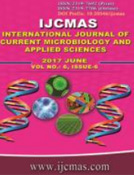


 National Academy of Agricultural Sciences (NAAS)
National Academy of Agricultural Sciences (NAAS)

|
PRINT ISSN : 2319-7692
Online ISSN : 2319-7706 Issues : 12 per year Publisher : Excellent Publishers Email : editorijcmas@gmail.com / submit@ijcmas.com Editor-in-chief: Dr.M.Prakash Index Copernicus ICV 2018: 95.39 NAAS RATING 2020: 5.38 |
Field experiments were conducted from 2010 to 2012 at Zonal Agricultural Research Station, Mandya to study the effect of farmyard manure and bio-digester liquid manure on the performance of aerobic rice – field bean cropping sequence. Soil was red sandy loam in texture, low in organic carbon (0.38 %) and available nitrogen (215.5 kg ha-1), medium in available P2O5 (26.2 kg ha-1) and K2O (162.3 kg ha-1). Significantly higher organic carbon content (0.51 %) after harvest of aerobic rice was found with FYM 12.5 t + BDLME to 150 kg N ha-1 and 0.55% with FYM 10 t + BDLME to 35 kg N ha-1 after harvest of field bean. Significantly higher available nitrogen (356.2 kg ha-1), P2O5 (69.5 kg ha-1) and K2O (208.0 kg ha-1) after harvest of aerobic rice were noticed by the application of FYM 12.5 t + BDLME to 75 kg N ha-1 as compared to recommended practice. Similarly, higher available nitrogen (362.3 kg ha-1), P2O5 (87.2 kg ha-1) and K2O (227.8 kg ha-1) after harvest of field bean were noticed with of FYM 10 t + BDLME to 20 kg N ha-1 as compared to recommended practice. Significantly higher population of bacteria (24.2 cfu X 105 g-1 of soil), fungi (16.4 cfu X 103 g-1 s of soil) and actinomycetes (11.2 cfu X 104 g-1 of soil) after harvest of aerobic rice was found with FYM 12.5 t + BDLME to 150 kg N ha-1 as compared to the recommended practice but was on par with FYM 12.5 t + BDLME to 125 kg N ha-1. In the same context, higher population of bacteria (25.8 cfu X 105 g-1 soil), fungi (17.4 cfu X 103 g-1 soil) and actinomycetes (12.2 cfu X 104 g-1 soil) after harvest of field bean were found with the application of FYM 10 t + BDLME to 35 kg N ha-1 as compared to that of recommended practice but was on par with FYM 10 t + BDLME to 30 kg N ha-1 but, was on par with FYM 10 t + BDLME to 30 kg N ha-1.
 |
 |
 |
 |
 |